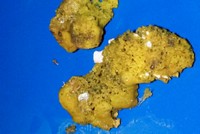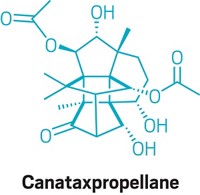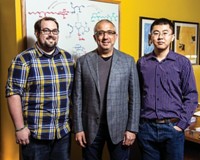Advertisement
Grab your lab coat. Let's get started
Welcome!
Welcome!
Create an account below to get 6 C&EN articles per month, receive newsletters and more - all free.
It seems this is your first time logging in online. Please enter the following information to continue.
As an ACS member you automatically get access to this site. All we need is few more details to create your reading experience.
Not you? Sign in with a different account.
Not you? Sign in with a different account.
ERROR 1
ERROR 1
ERROR 2
ERROR 2
ERROR 2
ERROR 2
ERROR 2
Password and Confirm password must match.
If you have an ACS member number, please enter it here so we can link this account to your membership. (optional)
ERROR 2
ACS values your privacy. By submitting your information, you are gaining access to C&EN and subscribing to our weekly newsletter. We use the information you provide to make your reading experience better, and we will never sell your data to third party members.
Synthesis
Marine Alkaloid Total Synthesis
Norzoanthamine shows promise for treating osteoporosis
by Bethany Halford
June 21, 2004
| A version of this story appeared in
Volume 82, Issue 25
The first total synthesis of norzoanthamine—a heptacyclic marine alkaloid first isolated from Zoanthus sp. anemones and characterized nearly 10 years ago—has been achieved by a group at Japan’s Hokkaido University [Science, published online June 17, http://www.sciencemag.org/cgi
/content/abstract/1098851v1]. Chemistry professor Masaaki Miyashita tells C&EN that his group’s stereoselective synthesis produces the alkaloid in 41 steps with a 3.5% overall yield.
Norzoanthamine is a tantalizing target for synthetic chemists. Not only does its complex molecular architecture pose an intellectual challenge, but the compound and its analogs have a variety of medicinal applications. Most notably, animal studies have shown that norzoanthamine is a promising drug candidate for treating osteoporosis.

Unfortunately, it simply isn’t feasible to extract from natural sources the large amounts of material needed for preclinical and clinical testing, according to Daisuke Uemura, a chemistry professor at Nagoya University, in Japan, who first isolated and characterized norzoanthamine and did the antiosteoporosis studies. Consequently, Uemura says, Miyashita’s synthetic route represents a powerful tool in advancing the study of norzoanthamine as a therapeutic drug.
The Hokkaido group spent five years developing the route to norzoanthamine, according to Miyashita. From the perspective of both stereochemistry and functional groups, the structure possesses a number of synthetically challenging elements, such as the trans-anti-trans-fused perhydrophenanthrene skeleton of three rings in the molecule’s framework and two amino acetal structures, one of which includes a bridged  -lactone. Nevertheless, Miyashita says that building the alkaloid’s ring with three adjacent, quaternary chiral centers proved to be the most formidable task.
-lactone. Nevertheless, Miyashita says that building the alkaloid’s ring with three adjacent, quaternary chiral centers proved to be the most formidable task.
To tackle this complex and stereochemically dense element, Miyashita’s team took a cue from the proposed biogenic pathway and decided to construct part of the molecular framework via an intramolecular Diels-Alder reaction. To build the requisite chiral triene, they employed a three-component coupling reaction followed by photosensitized oxidation of a furan ring. The crucial Diels-Alder reaction proceeded as Miyashita and coworkers expected, giving the desired exo adduct as the major product.
“This synthesis is teeming with highly interesting and selective structural transformations,” says Princeton University chemistry professor Erik J. Sorensen. “Serious students of chemical synthesis will study this work carefully for its logic. It is admirable in design and execution.”
David R. Williams, a chemistry professor at Indiana University, Bloomington, concurs. “The Hokkaido team has demonstrated finesse and sensitivity in a synthetic design which skillfully avoids the many pitfalls arising from competing reactivity in a complex system. This report is a breakthrough which will yield access to new substances as probes for very significant biological studies.”






Join the conversation
Contact the reporter
Submit a Letter to the Editor for publication
Engage with us on Twitter